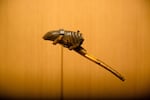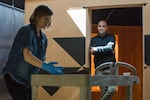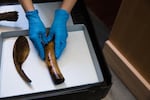Travis Stewart pressed suction-cup handles — the kind you might expect to see in a spy movie — firmly onto the museum display glass.
It was a Wednesday in late May and Stewart’s first major exhibit was coming to an end.
He worked swiftly but carefully to pull panes from the wall in the dim orange glow of display lights.
Behind four glass panels were 16 historic artifacts originally belonging to the Confederated Tribes of Grand Ronde: a dance rattle made from deer toes, a seed basket and beater, a horned hunting cap, to name a few. The items had been on display at the Chachalu Museum and Cultural Center in Grand Ronde, between Salem and the coast, for the past year.

An adze handle is pictured Tuesday, May 21, 2019, at the Chachalu Museum and Cultural Center in Grand Ronde, Ore. The handle would be hafted with a blade and used for carving canoes and general woodworking. The exhibit for the Summers Collection items featured no labels, encouraging visitors to look harder and closer at the artifacts. "You’re kind of being drawn and immersed in your history because your history is always happening," Stewart said.
Bradley W. Parks / OPB
The small, spare, circular room inside an oversized bentwood box where Stewart worked was just one product of a decadeslong campaign to repatriate ancestral items to the tribes.
That effort — which included several trips to London and the construction of a museum and vault — resulted in an atypical one-year loan from the British Museum to bring the items home to Oregon.
“We didn’t just want to get these items from the [Rev. Robert] Summers Collection loaned and to come in and be on display for a year,” said Stewart, the tribe’s interpretive coordinator. “... What we wanted was the traditional knowledge that went into making those.”
Grand Ronde tribal members have spent the past year studying, scanning and injecting new life into the objects once collected by an episcopal minister in the 1870s as remnants of a dying culture.
In so doing they’ve subverted the idea of the museum as a memorial to the past, instead making Chachalu a cultural incubator for the future.
30-Year Lobby, 1-Year Loan
Before last May, the artifacts in the Summers Collection spent more than a century stowed out of sight in a London warehouse.
Summers was Rev. Robert W. Summers, a minister who began purchasing and trading for objects in the 1870s from people forcibly relocated to Grand Ronde two decades prior. He collected under the assumption that the peoples living at Grand Ronde would soon be extinct.
Summers’ health deteriorated toward the end of the century, so he sold his collection to a colleague, who gifted it to the British Museum in 1900. The items have since sat in storage, never displayed publicly.
At the same time, the tribes thwarted attempts by the U.S. government to erase their people's very existence.
“Our rights, our identity, our land — all of that was taken,” said Cheryle A. Kennedy, Tribal Council chairwoman. “But a little group of Grand Ronde people got together and we said, ‘No more. We’re not taking this. We are who we are. We’re not a club. We’re a distinct group of people.’”
The Confederated Tribes of Grand Ronde regained federal recognition in 1983 after several years of restorative efforts. Soon they began seeking repatriation of the Summers Collection items.
“As we were told in the readings I’ve seen was that if we do survive, then these articles are to be returned to us,” Kennedy said.
Kennedy earned a seat on the Tribal Council in 2000 and two years later went to the British Museum to visit the artifacts. She said she was dismayed to learn the items had spent all those years in storage rather than in public view. That deepened her desire, she said, to bring them home.
“If they’re not of value to you, they are to us. I don’t care what they look like,” she recalled. “These were made by the hands of my grandparents and I want them.”
But the British Museum locks its collection under the British Museum Act 1963, which makes "disposal of objects" (or repatriation) virtually unattainable without an act of Parliament.
Securing even a short-term loan of items from the Summers Collection came at a steep cost.
The tribes needed exhibit space and somewhere to store the items. They had to pay for couriers to transport the items to and from England.

Travis Stewart, right, leans against the bentwood box display as Amber Lincoln prepares Grand Ronde tribal artifacts to return to London. Bentwood boxes were traditionally used for storage and inspired the exhibit Stewart helped design. "After seeing these things stored in different collections, different items throughout the world, this was a way of showing how we would store something of importance," he said.
Bradley W. Parks / OPB
Construction of a museum had been a priority of the Grand Ronde tribes throughout their restoration effort. Reclaiming the Summers Collection was always top of mind.
They converted the old Willamina Middle School into the Chachalu Museum and Cultural Center. Chachalu "Phase I" opened in 2014.
The British Museum approved a one-year loan of 16 items from the Summers Collection as the tribes planned to open Chachalu "Phase II." The renovated space, which opened last year, featured a larger exhibit hall with the Summers items as its centerpiece.
Old Tech Meets New Tech
The blackened shells of deer toes fanned out in a circle around a pile of cords on the screen in front of Nicolas Atanacio and Dustin Hawks.
“Dude,” Atanacio whispered in awe. “What?!”
They used a giant tablet to manipulate a 3D scan of the actual deer toe rattle that had sat behind display glass in the room next door.
During the Summers items’ time in Grand Ronde, the tribes used photogrammetry and 3D scanning to make virtual copies of the artifacts. The technology affords cultural interpreters a level of detail they couldn’t get before with items like the centuries-old rattle without damaging them.
Atanacio is a historic preservation technician and Hawks a cultural resource protection specialist for the tribes.
Atanacio zoomed in to take a closer look. He pointed to the hairlike fibers delicately twisted and braided to hold the deer toes in place. The tribes recently learned the cordage is made of wild iris, which has tensile strength similar to silk.
“That’s really nice detail,” Hawks said.
“That’s wild to me,” Atanacio replied, “because that’s so much work.”
That pairing of old tech with new tech has helped fill critical gaps in the Grand Ronde story.
Many of the artifacts were made before European contact, so they encompass some of the diversity of the Grand Ronde tribes, who came from all over the Northwest.
“For a long time, this area, the reservation here at Grand Ronde, has come to define Grand Ronde people as opposed to the places they come from,” said Stewart, the interpretive coordinator.

Nicolas Atanacio manipulates a 3D scan of a horn bowl in the interpretation room at Chachalu Museum and Cultural Center in Grand Ronde, Ore., Tuesday, May 21, 2019. The scans have helped cultural interpreters get up close with historic artifacts to learn how they're made without damaging them.
Bradley W. Parks / OPB
Summers kept detailed journals about the items he collected, what they were made of and where the materials came from. He also often recorded the names of people from whom he obtained objects, which helped tribal members trace them back to family members.
For many in Grand Ronde, the items’ temporary stay at home was a chance to reconnect with ancestors. But freeing the objects from private storage in London has also unlocked a wealth of ancestral knowledge that’s helping to sustain and evolve cultures thousands of years old.
“The value is to regain that knowledge — the value to us anyway,” Stewart said. “It’s not just to have it on display, it’s to be able to recreate those things.”
‘Decolonizing The Museum’
The British Museum’s loan to Chachalu ended last Thursday.
Amber Lincoln, a curator with the British Museum, delicately plucked articles from their respective perches using blue latex gloves as Stewart removed the glass panes.

Amber Lincoln, Americas curator with the British Museum, places a dentalium purse on a tray as she prepares Summers Collection items to return to London on Wednesday, May 29, 2019. The Grand Ronde tribes have started making new versions of items on display at Chachalu. "The role of museums is to sort of facilitate what’s already happening here," Lincoln said. "If historical objects can help in this process then this is what we need to be doing."
Bradley W. Parks / OPB
The role of museums as gatekeepers of history and culture has long been called into question. Many of the world's oldest and largest cultural institutions, like the British Museum, are steeped in colonial bureaucracy.
Lincoln said relationships like the one between the British Museum and Chachalu are positive if small steps toward making museums and museum culture more equitable.
“Decolonizing the museum doesn’t begin and end in curation,” she said. “It needs to go further into the way that museums are operated, the way that people are financially repaid, how tickets and flight itineraries and all that sort of thing are arranged — just the simplest points.”
As she prepared the items for their return to London, a few steps away in Chachalu’s cultural education room, Flicka LaBonte Lucero continued work on a water-tight basket. It’s one of the items in the Summers Collection tribal members have begun making again.
They’ve started several water-tight and burden baskets. They recently finished a new deer toe dance rattle. The making of seed beaters — used to harvest tarweed seeds — was a lost craft before the artifacts’ return.
Cultural preservation specialists like LaBonte are teaching these rediscovered techniques to tribal members of all ages. She’s close to becoming a master weaver herself.

Flicka LaBonte Lucero weaves a water-tight cooking basket in the cultural education room at Chachalu Museum and Cultural Center in Grand Ronde, Ore., Wednesday, May 29, 2019. The basket is one of several items the Confederated Tribes of Grand Ronde have started making again to reintroduce into daily life.
Bradley W. Parks / OPB
The cultural education program is one of the ways Chachalu has tried to rethink its role as a museum. It’s less a monument to history and more of a learning lab.
“Well, they’re teachers,” said Kennedy, the Council chairwoman. “And when you teach, you impart in the audience these lessons that they might not learn anywhere else.
“I think that the job of a museum is really to pique the interest of the average person so that they can learn to dig a little deeper and to really know truths.”
The Confederated Tribes of Grand Ronde will continue to work with the British Museum to bring more artifacts from the Summers Collection home in the future — perhaps one day for good.
The Chachalu Museum and Cultural Center’s next exhibit will explore Tomanowos, a sacred meteorite that glacial floods carried to the Willamette Valley 13,000 years ago. The exhibit called “Witness” will open in June.
Words and photos by Bradley W. Parks. Video by Arya Surowidjojo. 3D scan courtesy of the Confederated Tribes of Grand Ronde, animated by OPB’s MacGregor Campbell.
